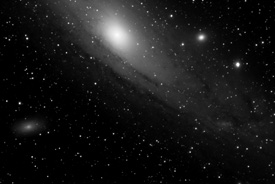 M31,
the famous Andromeda Galaxy, M32 and NGC 205, 09/26/2003, 9 images of 10 minutes, ST-8e, 5inch FH-Refractor, IR-cut, jpeg 233k
M31,
the famous Andromeda Galaxy, M32 and NGC 205, 09/26/2003, 9 images of 10 minutes, ST-8e, 5inch FH-Refractor, IR-cut, jpeg 233k
Next to the Magellanic Clouds which belong to our own Galaxy, the Andromeda
Galaxy is the nearest extra galactic system (perhaps), and of course it
is not boring to observe. It is the largest member in our Local Group of
Galaxies. As it is with every thing else, the more you know about it, the
more interesting it is.
Beside the not easy to see spiral structure, which is obvious visible
on every photograph, there are several details to observe even with modest
amateur equipement. Yes, it is true, that it takes the Hubble Space Telescope
to see so much detail in any Virgo galaxy, as best amateur images reveal
about the secrets of M31. Some of these objects will be identified below.
The first image gives an overview of this nearby galaxy and the two accompanying systems M32 and NGC 205, sometimes called M110 (on the right side).
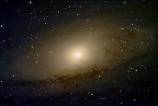 Core of Andromeda Galaxy, jpeg, 176k
Core of Andromeda Galaxy, jpeg, 176k
Image data: 12 images of 45 seconds integration time were combined. Canon 50d, sRAW, ISO 1600, 12" Newton, F/6, Paracorr, 2010/10/10.
Also shown at the indicated position is Nova M31 2010-10a, CBET 2483, discovered 2010/10/05.551 by Koichi Nishiyama and Fujio Kabashima.
The following 4 images show the four brightest companions of M31 in more detail. The whole M31 system consists of six additional faint dwarf galaxies AND I-VI, where the last two of them where only recently (summer 1998, January 6, 1999) discovered.(See link at the end of this page). They are also the newest members of the Local Group, the group of galaxies within a distance of 4 million light-years to which our own Galaxy belongs. Detection of another large member of the Local Group, a low surface brightness galaxy, somewhat hidden by our own Milky Way, found in the constellation Cepheus, was announced last November (1998). The current number of 43 members in this club of nearest neighbors in the universe will not stand for long.
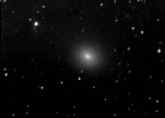 M32, Companion of
M31 in Andromeda, jpeg, 3.5k
M32, Companion of
M31 in Andromeda, jpeg, 3.5k
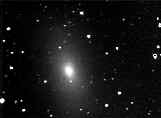 NGC 205, Companion of M31 in Andromeda, 09/19/98, jpeg, 23k
NGC 205, Companion of M31 in Andromeda, 09/19/98, jpeg, 23k
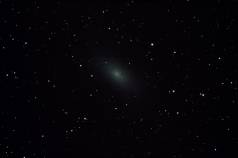 NGC 205, Companion of M31 in Andromeda, 10/10/2010, jpeg, 176k
NGC 205, Companion of M31 in Andromeda, 10/10/2010, jpeg, 176k
See the dusty patch down to the left from the center of NGC 205 (image above). It is quite unusual to find dust and gas in elliptical galaxies.
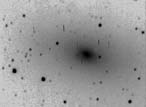 Seven of the eight
Globular
clusters of NGC 205 are marked in this image. They just have numbers
instead of names. From left to right: G61, G63, G54, G51, G57, G56, G55.
(Ref. Hodge's Atlas of the Andromeda Galaxy )
Seven of the eight
Globular
clusters of NGC 205 are marked in this image. They just have numbers
instead of names. From left to right: G61, G63, G54, G51, G57, G56, G55.
(Ref. Hodge's Atlas of the Andromeda Galaxy )
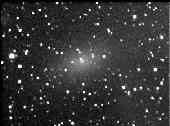 NGC 147, Faint companion of M31 in Cassiopeia, jpeg, 41k
NGC 147, Faint companion of M31 in Cassiopeia, jpeg, 41k
A little bit more than 7 degrees to the north of M31, already in the constellation of Cassiopeia, NGC 147 and NGC 185 are found side by side, separated less than a degree.
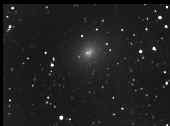 NGC 185, Faint companion of M31 in Cassiopeia, jpeg, 14k
NGC 185, Faint companion of M31 in Cassiopeia, jpeg, 14k
As in the image of NGC 205 above, a small dust cloud is visible here.
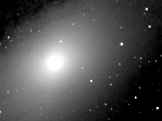 M31, Central part with dust lanes,08/14/98, jpeg, 17k
M31, Central part with dust lanes,08/14/98, jpeg, 17k
It is known since 1993 that the Andromeda galaxy has a double nucleus.The Hubble Space Telescope was used to resolve the two peaks. As they have an apparent distance of less than 0.5" it is nearly impossible to split it with ground based telescopes.
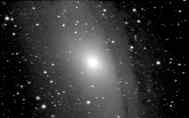 M31, Central part with dust lanes, 500 mm F/8 , jpeg, 23k
M31, Central part with dust lanes, 500 mm F/8 , jpeg, 23k
The same CCD-image as a finder chart for many objects in M31
500 mm focal length, 500 grams weight, my little giant. This small catadioptric system, combined with a CCD camera shows several objects at the indicated positions in M31. Globular clusters are designated with a G. The brightest is G78 with 14.3 mag and the faintest, G254 has 15.7 mag. Single stars are A,B,C,D,E,29a. They are super giants of 13.0, 12.1, 12.0, 12.2, 12.7, 14.7 mag. Association A67 contains two emission knots, A29 has a prominent HII region. C259 and C270 are examples for open clusters. (Data are from Brian Skiff: All about M31, in 'Galaxies and the Universe' by David J. Eichler, 1992)
Two novae appeared next to the center of M31 in late summer 1998. Weather conditions did not permit me to image the first one, but I succeeded with the next. The nova is indicated at the position in the image shown below. A somewhat different processed image was also published in the german astro journal Sterne und Weltraum 1/99. To my knowledge it was the first published amateur image of an extra galactic nova.
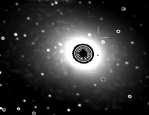 Nova
in M31, 09/21/98, 4x, jpeg 32k
Nova
in M31, 09/21/98, 4x, jpeg 32k
Only a few days before, there was another, even harder to get nova in M32. Read how it came into view on my special page about novae and supernovae.
Adjust your monitor to see the faint outer features in the images.
A very interesting image of M31, made with the 100m Effelsberg radio
telescope can be found here.
It shows a ring at 30000 light-years from the center, which resulted from
hundreds of supernova explosions...
Perhaps also interesting for deep-sky-fans is the fact, that almost
all circular objects in this image are not stars but quasars, standing
far in the background of M31.
The first Supernova in modern times appeared in the Andromeda galaxy in 1885. It remaind the only (observed) one in this system until today. As two to three should blow up per century, it can't take long to the next one. Be prepared !
More images of galaxies can be found on my pages about
Comments welcome, contact:
